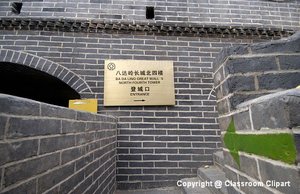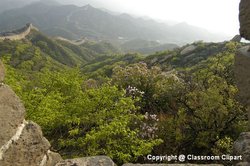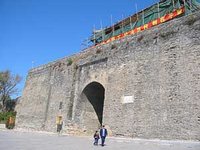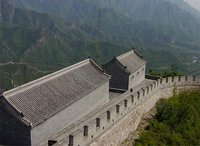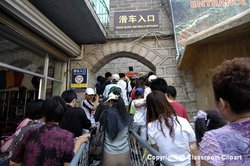Great Wall of China
|
|
The Great Wall of China also known in China as the Great Wall of 10,000 Li¹ is an ancient Chinese fortification built from the end of the 15th century until the beginning of the 16th century, during the Ming Dynasty, in order to protect China from raids by the Mongols and Turkic tribes. It was preceded by several walls built since the 3rd century BC against the raids of nomadic tribes coming from areas now in modern day Mongolia and Manchuria.
The Wall stretches over a formidable 6,350 km (3,946 miles), from Shanhai Pass on the Bohai Gulf in the east, at the limit between China proper and Manchuria, to Lop Nur in the southeastern portion of Xinjiang Uygur Autonomous Region.| Contents |
History
The first major wall was built during the reign of The First Emperor, the main emperor of the short-lived Qin dynasty. This wall was not constructed as a single endeavor, but rather was created by the joining of several regional walls built by the Warring States. It was located much further north than the current Great Wall, and very little remains of it. A defensive wall on the northern border was built and maintained by several dynasties at different times in Chinese history. The Great Wall that can still be seen today was built during the Ming Dynasty, on a much larger scale and with longer lasting materials (solid stone used for the sides and the top of the Wall) than any wall that had been built before. The primary purpose of the wall was not to keep out people, who could scale the wall, but to insure that semi-nomadic people on the outside of the wall could not cross with their horses or return easily with stolen property.There have been four major walls:
- 208 BC (the Qin Dynasty)
- 1st century BC (the Han Dynasty)
- 1138 - 1198 (the Five Dynasties and Ten Kingdoms Period)
- 1368-1620 (from Hongwu Emperor until Wanli Emperor of the Ming Dynasty)
The Ming Dynasty Great Wall starts on the eastern end at Shanhai Pass, near Qinhuangdao, in Hebei Province, next to Bohai Gulf. Spanning nine provinces and 100 counties, the final 500 kilometers have all but turned to rubble, and today it ends on the western end at the historic site of Jiayu Pass (嘉峪关), located in northwest Gansu Province at the limit of the Gobi Desert and the oases of the Silk Road. Jiayu Pass was intended to greet travelers along the Silk Road. Even though The Great Wall ends at Jiayu Pass, there are many watchtowers (烽火台 fēng huǒ tᩩ extending beyond Jiayu Pass along the Silk Road. These towers communicated by smoke to signal invasion.
The Kokes Manchus crossed the Wall by convincing an important general Wu Sangui to open the gates of Shanhai Pass and allow the Manchus to cross. Legend has it that they took three days for the Manchu armies to pass. After they conquered China, the Wall was of no strategic value as the people who the Wall was intended to keep out were ruling the country (becoming the Qing Dynasty).
The government ordered people to work on the wall, and workers were under perpetual danger of being attacked by brigands. Because many people died while building the wall, it has obtained the gruesome title, "longest cemetery on Earth" or "the long graveyard". Their bodies were not entombed in the wall, however. A body buried in the wall would have weakened its structure, so workers were buried nearby instead.
Condition
While some portions near tourist centers have been preserved and even reconstructed, in most locations the Wall is in disrepair, serving as a playground for some villages and a source of stones to rebuild houses and roads. Sections of the Wall are also prone to graffiti. Parts have been bulldozed because the Wall is in the way of construction projects.Today the Great Wall Society of China works to preserve the Wall. Through June 2003, the Chinese government still had no laws written to protect the Wall nationwide. However, Beijing has enacted local legislation which would prohibit visits to the "wild Great Wall" or parts not open to the public; this has been in force since August 2003.
Walls
Significant passes (Template:Zh-tsp) include:- Shānhǎi Pass (山海關)
- Jiayu Pass (嘉峪关),
- Jūyōng Pass (居庸關)
- Niᮧzi Pass (娘子關)
Watchtowers and Barracks
The wall is complemented by defensive fighting stations, to which wall defenders may retreat if overwhelmed.Each tower has unique and restricted stairways and entries to confuse attackers.
Barracks and administrative centers are located at larger intervals.
Materials
The materials used are those available near the site of construction. Near Beijing the wall is constructed from quarried limestone blocks. In other locations it may be quarried granite or fired brick. Where such materials are used, two finished walls are erected with earth and rubble fill placed in between with a final paving to form a single unit. In some areas the blocks were cemented with a mixture of glutinous rice and eggwhite.In the extreme western desert locations, where good materials are scarce, the wall was constructed from dirt rammed between rough wood tied together with woven mats.
Specialized defense weapons
In addition to the usual military weapons of the period, specialized wall defense weapons were used.Reproductions of weapons are displayed at the wall.
Recognition
The Wall is included in lists of the "Seven Medieval Wonders of the World" but was of course not one of the classical Seven Wonders of the World recognized by the ancient Greeks.The Wall was made a UNESCO World Heritage Site in 1987.
There is a great debate about how visible the wall is in space. 1938, Richard Halliburton's Second Book of Marvels said the Great Wall is the only man-made object visible from the moon. This persisted, assuming urban legend status - sometimes even entering school textbooks. The Great Wall can simply not be seen by the unaided eye from the distance of the moon. Even its visibility from near earth orbit is questionable.
One shuttle astronaut reported that "we can see things as small as airport runways [but] the Great Wall is almost invisible from only 180 miles (290 km) up." Astronaut William Pogue thought he had seen it from Skylab but discovered he was actually looking at the Grand Canal near Peking. He spotted the Great Wall with binoculars, but said that "it wasn't visible to the unaided eye." An Apollo astronaut said no human structures were visible at a distance of a few thousand miles. Chinese astronaut Yang Liwei said he couldn't see it at all.
From low earth orbit, about a thousand times nearer than the moon, it may be visible under favorable conditions. Features on the moon that are dramatically visible at times can be undetectable on others, due to changes in lighting direction. The Great Wall is only a few meters wide - sized similar to highways and airport runways - and is about the same color as the soil surrounding it.
Veteran U.S. astronaut Gene Cernan has stated: "At Earth orbit of 160 km to 320 km high, the Great Wall of China is, indeed, visible to the naked eye." Ed Lu, Expedition 7 Science Officer aboard the International Space Station, adds that, "...it's less visible than a lot of other objects. And you have to know where to look." A recent photograph taken from the International Space Station appears to confirm that China's Great Wall can be seen with the naked eye after all. Leroy Chiao, a Chinese-American astronaut, took what the state-run China Daily newspaper says is the first photographic evidence that the Great Wall could be seen from space with the naked eye, under certain favorable viewing conditions and if one knows exactly where to look. ([1] (http://news.bbc.co.uk/2/hi/asia-pacific/4459311.stm))
See also
Photographs of the Great Wall
- Photographs of the Great Wall (http://classroomclipart.com/cgi-bin/kids/imageFolio.cgi?direct=New/Great_Wall)
- Photographs of China (http://classroomclipart.com/cgi-bin/kids/imageFolio.cgi?direct=Countries_and_Cities/China)
Further reading
External links
- Great Wall of China (http://www.travelchinaguide.com/china_great_wall/index.htm)
- Pictures of Great Wall of China (http://www.travelchinaguide.com/picture/china_great_wall/index.htm)
- CBC.ca News: "Great Wall invisible from space": Chinese astronaut (http://www.cbc.ca/stories/2004/03/12/world/great_wall040312)
- Snopes urban legend site (http://www.snopes.com/science/greatwal.htm) Great Wall's lack of visibility from space
- Great Wall of China & Volunteer of Great Wall (http://www.thegreatwall.com.cn/en)
- Great Wall of China (http://www.beijingservice.com/greatwall.htm)
Notes
¹ 10,000 li = 5,760 km. (3,580 miles). In Chinese, 10,000 figuratively means "infinite", and the number should not be interpreted for its actual value, but rather as meaning the "infinitely long wall".


